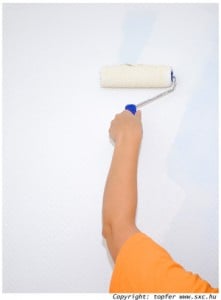Decorate Using Color Psychology

According to a recent study in color psychology, color is a major influence in many of our general decisions. For example, blue is said to prompt one to eat less, so painting a dining room blue would be counteractive when it comes to the overall functions of the room itself.
It’s important to have a basic understanding of color psychology before decorating a home because the colors we choose can influence our moods, display our personalities and show things about our cultural context.
Your Favorite Color and Your Personality
We usually choose certain colors to be our favorites because of certain subconscious associations we have with them.
Our intuitive sides can pick up on the vibes each color tells us, cluing us in to what type of person we really are and some things that we have been through. This is important in home textiles because, for example, a person who is more inclined to the color purple tends to be more compassionate, intuitive, and has high standards. A person who favors the color yellow is capable, quick-witted, spontaneous, confident and a good communicator, according to the book “Color for Life” by Charles Phillips.
If one were to choose certain colors to paint a house, these colors could indicate whether they’re a caring person or a high-maintenance person.
Social Associations with Color
What one color means to one culture can be completely different in another culture. Consider the color white. In Western culture, white represents innocence, purity, and peace. It is most notable as the appropriate color for a wedding dress. However, in some Eastern cultures, white is considered to be the color of mourning.
This shows that colors can be misinterpreted by those of different cultural backgrounds. This makes it difficult, when researching human responses to colors, to differentiate between a social/cultural association with a color and a color’s physiological effect on the body. For this reason, researchers like to do color personality tests on children because they are not as influenced by culture. However, children still have some cultural and social influence when taking the test, which proves how hard it can be to see the difference. Sometimes an association with a color based on their experience with it can lead to a physiological effect. For example, if a person who is squeamish or does not like blood sees too much of the color red, it can make him or her nauseous because of its past associations, not the color itself.
Color’s Physiological Effects
Although there are many social contexts that we associate with colors, there are many things about colors that have an actual physiological effect on our bodies.
Blue is a color that promotes a calming vibe and is more relaxing, whereas red is a more aggressive color that can lead to anger, passion, or love depending on how that person values that color. Regardless of how a person perceives a color, it still affects our moods. Knowing what colors influence your mood will help make your home more functional. For example, orange is a color that represents energy, so if one were to paint their workout room orange, it could encourage them to push through a strenuous workout.
This is actually one of the most controversial topics about color psychology. Some believe that our social associations with color are the only effect on us, and there is no way that color has an effect on our bodies.
Contrary to many beliefs, there have actually been scientific studies that confirm that color has a physiological effect on our bodies. A study was done on patients with Parkinson’s disease, for example. Red shades worsened the patient’s pathological condition, but green shades improved it. This is because color is a form of energy, and it affects the body in many places, including brain waves, emotion, the autonomic nervous system and hormonal activity. Certain colors arouse different aspects of the body. If color psychology is applied properly to one’s decorating, it could improve health by putting one in an appropriate mood for the right times.
Benefits of Color Psychology in Decoration
Knowing that color has such a powerful affect on our bodies also has much importance on what we decide to paint our interiors. Acceptance is something that we as humans not only want, but need, according to Maslow’s hierarchy of needs. Before decorating a room, person should first decide what type of vibe he or she wants the room to have. The second thing the person should ask him- or herself is what colors are aesthetically pleasing. Even if a color would be most functional for a room, it could still have a negative connotation with some people. After interpreting these two aspects of the process, a person can begin the interior decorating process.
What Do These Colors Mean?
Because different colors stimulate different parts of the body, it is best to know which colors would be appropriate for each room.
Warm Colors
Warm colors have more of an exciting effect on the body and even increase the pulse. Red stimulates conversation and promotes activity, so red is good in hallways and small rooms in passing, like a bathroom or even a living room. Yellow is the most excitable color and promotes optimism as well as mental activity. This is a perfect color for a study. Orange is another active color that promotes active movement and energy. This would be the perfect color for an exercise room.
Cool Colors
Cooler colors have the opposite effect on our bodies, lowering the pulse and providing an overall calming effect. Blue for example has a tendency to relax the muscles and settle breathing, making it great for places of rest, like the bedroom or maybe the bathroom. Green is the color for meditation and overall calm. It is the most soothing color on the eye because it is in the middle of the color spectrum and therefore does not really have long or short wavelengths. It is good to add a little green to each room such as a plant to have that rest and peacefulness wherever one goes.
It is important that color psychology is taken into account when it comes to decorating ones home because it could influence one’s mood, people’s overall perception of them, and can represent one’s social and cultural experiences. If applied correctly, this can increase ones productivity in their own home and improve their health. If one were to choose the wrong colors the outcome could lead to all types of unexplainable emotions which would lead back to just a bad paint job. Colors are something that we are so used to having we can sometimes underestimate their power. I feel that if people were a little more knowledgeable about color psychology they would appreciate color more. Just in my studies about this has led me to think about life without color and what life would be like if it were only in black in white. I definitely have a better appreciation for color and a better sense at how to decorate my living spaces because of it.
Works Cited
1.) Mella, Dorothee L. (1988). The Language of Color. New York, NY: Warner Books.
2.) Mahnke, Mahnke, Frank H., Rudolph H. (1993). Color and light. New York, NY: Van Nostrand Reinhold.
3.) Phillips, Charles (2004). Color for Life. New York, NY: Ryland Peters & Small.
4.) (1993). Color Pyschlogy. The Voice of Color, Retrieved 4/ 24/ 2009, from https://www.voiceofcolor.com/en/aboutcolor/color_theory/psychologie/index
5.) S., E. (2006, April 7). Choose your color, Choose your mood. Retrieved April 24, 2009, from associatedcontent.com: https://www.associatedcontent.com/article/25938/choose_your_color_choose_your_mood.html?cat=6







